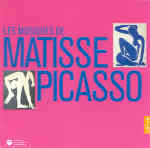Although there’s no explicit mention of it anywhere on this set, this mid-priced two-disc collection was released as a tie-in to an art exhibition currently traveling around Europe and the United States that showcases the two artists’ work and explores the complexities of their relationship with each other. Naturally enough, part of that larger story is situating these two giants of visual art in the context of other artistic currents of their times. Of course, when it comes to Matisse and Picasso, that’s not much of a stretch: each had a deep love of and involvement in music as well as in fine art. Matisse made portraits of Prokofiev and Alfred Cortot, knew Shostakovich and Gershwin, and was the dedicatee of Poulenc’s Sonata for Two Pianos. Picasso was friends with Satie, Cortot, and Poulenc, and famously collaborated with Stravinsky and Manuel de Falla as well as Satie. So matching these composers’ music, along with works of others beloved by the two artists (Bach, Billie Holiday, Louis Armstrong, and Dizzy Gilliespie) creates an interesting if ancillary avenue for investigating Matisse and Picasso.
Disc 1 focuses primarily on the classical: Falla’s Three-Cornered Hat (played by the Joven Orquesta Nacional de España, with Edmon Colomer); Poulenc’s Figure Humaine (Choeur de Chambre Accentus and Laurence Equilibey), the aforementioned sonata (Alexandre Tharaud and Franços Chaplin), and his Travail du peintre (baritone Bernard Kruysen and pianist Noël Lee); Shostakovich’s Tenth Symphony (Czecho-Slovak RSO Bratislava, Ladislav Slovak); Stravinsky’s Chant du rossignol (Ernest Bour conducting the Sinfonieorchester des Südwestfunks Baden-Baden) and Pulcinella (featuring tenor Ian Bostridge and Stefan Sanderling with the Bournemouth Sinfonietta); Satie’s Parade (the Duo Campion-Vachon); and a brief Terremoto, played by guitarist Moraito.
Disc 2 traverses both classical music and jazz: Ravel’s Left-Hand Piano Concerto (played by Cortot, with Charles Munch conducting the Orchestre de la Société des Concerts du Conservatoire de Paris); Gershwin’s Rhapsody in Blue (with Gershwin himself and Paul Whiteman and his orchestra); Bach’s A minor violin concerto (Menuhin, Monteux, and the Paris Symphony); and a selection of tunes performed by Billie Holiday, Louis Armstrong, and Dizzy Gillespie.
Whew–that’s all on two discs? Well, kind of, and that’s part of the problem: almost without exception the classical pieces are represented in truncated excerpts–which undoubtedly will be a turnoff for serious listeners. Equally troublesome is the extreme range of artistic accomplishment of the performances: they cover the good (such as the Poulenc extracts and early Billie Holiday), the bad (the sloppy Shostakovich Allegretto), and the ugly (Cortot’s ham-fisted Ravel). The sound quality also bounces wildly, depending on the source. You wonder if perhaps this sort of presentation would have been more successful if it had been executed in another medium (for example, as a series of radio programs) rather than as a conceptually jumbled and artistically uneven two-disc compendium. A better bet would be to find recommended, full-length performances of these works and explore them at your leisure.
































